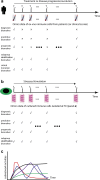A roadmap towards personalized immunology
- PMID: 29423275
- PMCID: PMC5802799
- DOI: 10.1038/s41540-017-0045-9
A roadmap towards personalized immunology
Erratum in
-
Author Correction: A roadmap towards personalized immunology.NPJ Syst Biol Appl. 2025 Jul 12;11(1):75. doi: 10.1038/s41540-025-00553-7. NPJ Syst Biol Appl. 2025. PMID: 40651937 Free PMC article. No abstract available.
Abstract
Big data generation and computational processing will enable medicine to evolve from a "one-size-fits-all" approach to precise patient stratification and treatment. Significant achievements using "Omics" data have been made especially in personalized oncology. However, immune cells relative to tumor cells show a much higher degree of complexity in heterogeneity, dynamics, memory-capability, plasticity and "social" interactions. There is still a long way ahead on translating our capability to identify potentially targetable personalized biomarkers into effective personalized therapy in immune-centralized diseases. Here, we discuss the recent advances and successful applications in "Omics" data utilization and network analysis on patients' samples of clinical trials and studies, as well as the major challenges and strategies towards personalized stratification and treatment for infectious or non-communicable inflammatory diseases such as autoimmune diseases or allergies. We provide a roadmap and highlight experimental, clinical, computational analysis, data management, ethical and regulatory issues to accelerate the implementation of personalized immunology.
Conflict of interest statement
The authors declare no competing financial interests.
Figures


Similar articles
-
A New Measure of Quantified Social Health Is Associated With Levels of Discomfort, Capability, and Mental and General Health Among Patients Seeking Musculoskeletal Specialty Care.Clin Orthop Relat Res. 2025 Apr 1;483(4):647-663. doi: 10.1097/CORR.0000000000003394. Epub 2025 Feb 5. Clin Orthop Relat Res. 2025. PMID: 39915110
-
Assessing the comparative effects of interventions in COPD: a tutorial on network meta-analysis for clinicians.Respir Res. 2024 Dec 21;25(1):438. doi: 10.1186/s12931-024-03056-x. Respir Res. 2024. PMID: 39709425 Free PMC article. Review.
-
Systemic pharmacological treatments for chronic plaque psoriasis: a network meta-analysis.Cochrane Database Syst Rev. 2021 Apr 19;4(4):CD011535. doi: 10.1002/14651858.CD011535.pub4. Cochrane Database Syst Rev. 2021. Update in: Cochrane Database Syst Rev. 2022 May 23;5:CD011535. doi: 10.1002/14651858.CD011535.pub5. PMID: 33871055 Free PMC article. Updated.
-
Antidepressants for pain management in adults with chronic pain: a network meta-analysis.Health Technol Assess. 2024 Oct;28(62):1-155. doi: 10.3310/MKRT2948. Health Technol Assess. 2024. PMID: 39367772 Free PMC article.
-
Interventions for central serous chorioretinopathy: a network meta-analysis.Cochrane Database Syst Rev. 2025 Jun 16;6(6):CD011841. doi: 10.1002/14651858.CD011841.pub3. Cochrane Database Syst Rev. 2025. PMID: 40522203
Cited by
-
Multi-Omics Profiling of the Tumor Microenvironment: Paving the Way to Precision Immuno-Oncology.Front Oncol. 2018 Oct 5;8:430. doi: 10.3389/fonc.2018.00430. eCollection 2018. Front Oncol. 2018. PMID: 30345255 Free PMC article. Review.
-
Multi-omics subgroups associated with glycaemic deterioration in type 2 diabetes: an IMI-RHAPSODY Study.Front Endocrinol (Lausanne). 2024 Mar 6;15:1350796. doi: 10.3389/fendo.2024.1350796. eCollection 2024. Front Endocrinol (Lausanne). 2024. PMID: 38510703 Free PMC article.
-
Multi-Omics Approaches in Immunological Research.Front Immunol. 2021 Jun 11;12:668045. doi: 10.3389/fimmu.2021.668045. eCollection 2021. Front Immunol. 2021. PMID: 34177908 Free PMC article. Review.
-
Vaccines to Prevent Infectious Diseases in the Older Population: Immunological Challenges and Future Perspectives.Front Immunol. 2020 Apr 23;11:717. doi: 10.3389/fimmu.2020.00717. eCollection 2020. Front Immunol. 2020. PMID: 32391017 Free PMC article. Review.
-
Comparative assessment of phenotypic markers in patients with chronic inflammation: Differences on Bifidobacterium concerning liver status.Eur J Clin Invest. 2025 Feb;55(2):e14339. doi: 10.1111/eci.14339. Epub 2024 Oct 28. Eur J Clin Invest. 2025. PMID: 39468772 Free PMC article.
References
-
- Council, N. R. Toward Precision Medicine: Building a Knowledge Network for Biomedical Research and a New Taxonomy of Disease (The National Academies Press, Washington, DC, 2011). - PubMed
-
- Duffy, D. et al. Functional analysis via standardized whole-blood stimulation systems defines the boundaries of a healthy immune response to complex stimuli. Immunity40, 436–450 (2014). - PubMed
-
- Willis, J. C. & Lord, G. M. Immune biomarkers: the promises and pitfalls of personalized medicine. Nat. Rev. Immunol.15, 323–329 (2015). - PubMed
-
- Schork, N. J. Personalized medicine: time for one-person trials. Nature520, 609–611 (2015). - PubMed
LinkOut - more resources
Full Text Sources
Other Literature Sources
Medical

